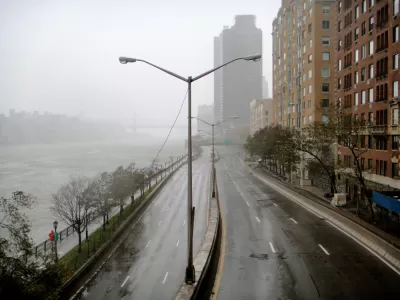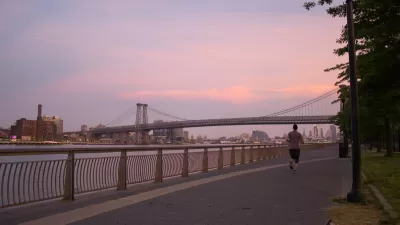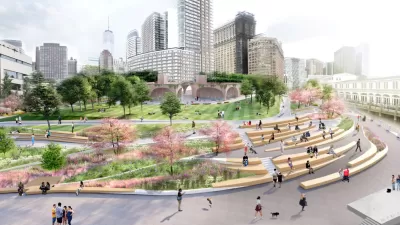A debate over how to protect the East River waterfront from Sandy-level flooding and storm damage has delayed the project as community activists decry the city's last-minute change of plans.

After Hurricane Sandy devastated Lower Manhattan in 2012, a federal grant competition sought out resilience projects that would protect East River Park and the surrounding neighborhood from future storms and flooding. A major recipient was a plan called the BIG U, which proposed natural barriers and berms that would allow occasional flooding and protect buildings. But rather than going ahead with the project, writes Michael Kimmelman, the city pulled the plug in 2018, citing cost concerns and proposing an alternate plan that would raise the coastline by adding more landfill instead.
Kimmelman outlines the history of East River Park and the public housing developments dotting the East River waterfront, and describes the community activists working to develop resilience plans for the area. After years of public consultation, the city's decision to change the proposed plan at the last minute and disregard community input has led to a contentious debate over the future of the area. The controversy divided the community and slowed progress on essential infrastructure needed to protect local residents and buildings.
Kimmelman describes the situation as a tension between community input and perceived expertise, between the inclusion of all voices and the urgent need for flood mitigation measures. After multiple delays due to lawsuits, design changes, and the pandemic, the city is moving forward with its new plan, scheduled for completion in 2026. The new levee is projected to protect the neighborhood until 2050.
You can also listen to the article on The Daily podcast.
FULL STORY: What does it mean to save a neighborhood?

Alabama: Trump Terminates Settlements for Black Communities Harmed By Raw Sewage
Trump deemed the landmark civil rights agreement “illegal DEI and environmental justice policy.”

Planetizen Federal Action Tracker
A weekly monitor of how Trump’s orders and actions are impacting planners and planning in America.

The 120 Year Old Tiny Home Villages That Sheltered San Francisco’s Earthquake Refugees
More than a century ago, San Francisco mobilized to house thousands of residents displaced by the 1906 earthquake. Could their strategy offer a model for the present?

Opinion: California’s SB 79 Would Improve Housing Affordability and Transit Access
A proposed bill would legalize transit-oriented development statewide.

Record Temperatures Prompt Push for Environmental Justice Bills
Nevada legislators are proposing laws that would mandate heat mitigation measures to protect residents from the impacts of extreme heat.

Downtown Pittsburgh Set to Gain 1,300 New Housing Units
Pittsburgh’s office buildings, many of which date back to the early 20th century, are prime candidates for conversion to housing.
Urban Design for Planners 1: Software Tools
This six-course series explores essential urban design concepts using open source software and equips planners with the tools they need to participate fully in the urban design process.
Planning for Universal Design
Learn the tools for implementing Universal Design in planning regulations.
Clanton & Associates, Inc.
Jessamine County Fiscal Court
Institute for Housing and Urban Development Studies (IHS)
City of Grandview
Harvard GSD Executive Education
Toledo-Lucas County Plan Commissions
Salt Lake City
NYU Wagner Graduate School of Public Service





























